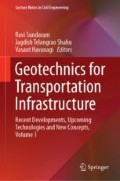Abstract
Slope stability analysis is a highly challenging task in geotechnical engineering as the influence of uncertainty involved in geotechnical properties on failure behavior of slopes is inevitable. Traditional deterministic slope stability approach, based on a single factor of safety (FoS) parameter, cannot explicitly encounter the uncertainties involved in geotechnical properties and failure mechanism, leading to erroneous results of slope stability. Hence, slope stability practice is highly persuadable to probabilistic treatment, which allows quantification of the uncertainty and rationally integrating the same into the analysis. The present study investigates the influence of inherent spatial variation of soil domain in probabilistic slope stability analysis. To accomplish this, a hypothetical slope is analyzed, considering 1D spatial variation, with the aid of GeoStudio 2007, using Morgenstern-Price limit equilibrium method (LEM) coupled with Monte Carlo simulation (MCS). The results are compared with those of Griffiths et al. (2007), wherein 2D random field for soil shear strength was considered and the analysis was carried out with the help of random finite element method (RFEM). The influence of correlation lengths on the probabilities of failure is compared. The results reveal that the probability of failure highly depends on spatial variation of soil property in both the methods. When correlation length is small, the failure probability is essentially zero; failure probability increases rapidly for intermediate correlation lengths, and for large correlation lengths, the failure probability becomes constant. It is also found that combining LEM with one-dimensional random field gives lower probabilities of failure than RFEM, as RFEM is more efficient in simulating the field uncertainty. Moreover, RFEM can search and identify the weakest path through the soil domain for the failure to occur, whereas LEM presumes a predefined failure plane.
Access this chapter
Tax calculation will be finalised at checkout
Purchases are for personal use only
References
Allahverdizadeh P, Griffiths DV, Fenton GA (2015) The random finite element method (RFEM) in probabilistic slope stability analysis with consideration of spatial variability of soil properties. IFCEE 2015. American Society of Civil Engineers, Reston, VA, pp 1946–1955
Chakraborty R, Dey A (2017) Importance of spatial variability on probabilistic slope stability. In: Indian geotechnical conference IGC 2017, IIT Guwahati, Guwahati, India, 14–16 December 2017
DeGroot DJ (1996) Analyzing spatial variability of in situ soil properties. In: Uncertainty in the geologic environment : from theory to practice: proceedings of Uncertainty ’96, pp. 210–238
Elkateb T, Chalaturnyk R, Robertson PK (2003) An overview of soil heterogeneity: quantification and implications on geotechnical field problems. Can Geotech J 40(1):1–15
Fenton GA, Griffiths DV (1993) Statistics of block conductivity through a simple bounded stochastic medium. Water Resour Res 29(6):1825–1830
Fenton GA, Griffiths DV (2008) Risk assessment in geotechnical engineering. John Wiley & Sons, Inc, Hoboken, NJ, USA
Griffiths DV, Fenton GA (2000) Influence of soil strength spatial variability on the stability of an undrained clay slope by finite elements. Slope stability 2000. American Society of Civil Engineers, Reston, VA, pp 184–193
Griffiths DV, Fenton GA (2007) Probabilistic methods in geotechnical engineering. CISM courses and lectures, vol 491
Griffiths DV, Fenton GA, Denavit MD (2007) Traditional and advanced probabilistic slope stability analysis. Probabilistic applications in geotechnical engineering. American Society of Civil Engineers, Reston, VA, pp 1–10
Griffiths DV, Asce F, Fenton GA, Asce M (2004) Probabilistic slope stability analysis by finite elements, 130: 507–518
Hicks MA, Nuttall JD, Chen J (2014) Influence of heterogeneity on 3D slope reliability and failure consequence. Comput Geotech 61:198–208
Jamshidi Chenari R, Alaie R (2015) Effects of anisotropy in correlation structure on the stability of an undrained clay slope. Georisk Assess Manage Risk Engineered Syst Geohazards 9(2):109–123
Jiang SH, Li DQ, Cao ZJ, Zhou CB, Phoon KK (2014) Efficient system reliability analysis of slope stability in spatially variable soils using monte carlo simulation. J Geotech Geoenviron Eng 141(2):1–13
Ji J, Liao HJ, Low BK (2011) Modeling 2-D spatial variation in slope reliability analysis using interpolated autocorrelations. Comput Geotech 40:135–146
Kitch W (1994) Deterministic and probabilistic analyses of reinforced soil slopes. Ph.D. dissertation, University of Texas, Austin, TX
Lacasse S, Nadim F (1996) Uncertainties in characterizing soil properties. In: Uncertainty in the Geologic Environment: from Theory to Practice, pp. 49–75
Li DQ, Qi XH, Phoon KK, Zhang LM, Zhou CB (2014) Effect of spatially variable shear strength parameters with linearly increasing mean trend on reliability of infinite slopes. Struct Saf 49:45–55
Li DQ, Jiang SH, Cao ZJ, Zhou W, Zhou CB, Zhang LM (2015) A multiple response-surface method for slope reliability analysis considering spatial variability of soil properties. Eng Geol 187:60–72
Lloret-Cabot M, Fenton GA, Hicks MA (2014) On the estimation of scale of fluctuation in geostatistics. Georisk Assess Manage Risk Eng Syst Geohazards 8(2):129–140
Morgenstern NR (2000) Performance in geotechnical practice—FCCN. In: The inaugural Lumb lecture. Hong Kong Institution of Engineers
Paice GM (1997) Finite element analysis of stochastic soils
Vanmarcke E (1977) Probabilistic modeling of soil profiles. J Geotech Eng Div
Vanmarcke E (1983) Random fields, analysis and synthesis. MIT Press, Cambridge
Author information
Authors and Affiliations
Corresponding author
Editor information
Editors and Affiliations
Rights and permissions
Copyright information
© 2019 Springer Nature Singapore Pte Ltd.
About this paper
Cite this paper
Chakraborty, R., Dey, A. (2019). A Comparison of 1D and 2D Spatial Variability in Probabilistic Slope Stability Analysis. In: Sundaram, R., Shahu, J., Havanagi, V. (eds) Geotechnics for Transportation Infrastructure. Lecture Notes in Civil Engineering , vol 28. Springer, Singapore. https://doi.org/10.1007/978-981-13-6701-4_34
Download citation
DOI: https://doi.org/10.1007/978-981-13-6701-4_34
Published:
Publisher Name: Springer, Singapore
Print ISBN: 978-981-13-6700-7
Online ISBN: 978-981-13-6701-4
eBook Packages: EngineeringEngineering (R0)

